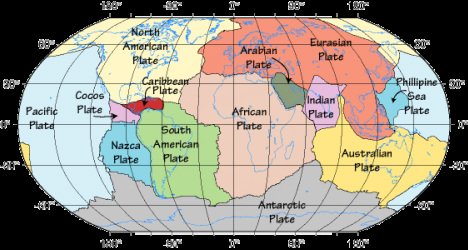Plate tectonics is a key concept underpinning our understanding of the earth and how it works. It is the idea that the earth’s surface, far from being static, is a thin skin of rigid rock which is constantly moving, albeit at a very slow rate. The continents and ocean floors which comprise the earth’s surface are being created and destroyed in cycles lasting for hundred of millions of years.
The Theory of Plate Tectonics: the Beginnings
Plate tectonics is a relatively recent branch of earth science, the brainchild of a German scientist, Alfred Wegener, who published a paper on the theory in 1915; although geologist Richard Fortey notes that Wegener’s initial paper was ‘largely dismissed’ and didn’t begin to be taken seriously until the 1930s.
Wegener’s theory (which was known as continental drift) was that the earth’s continents moved about across the ocean floor. His inspiration came from noticing the way in which continental shelves off the east and west coasts of the Atlantic Ocean, most particularly Africa and South America, seemed as if they ‘fitted’ together.
Further study indicated an excellent fit and as other scientists adapted the theory the fit of the continents was extended and was supported by other data, including the correlation of rocks of different ages lying on either side of the continents; the ‘trails’ of volcanic island chains such as Hawaii; and the pattern of magnetism of the earth’s rocks. The logical conclusion was that the earth must be made up of moving continental plates.
How Plate Tectonics Works
The mechanisms which drive the earth’s plates aren’t fully understood. It is thought that the heat contained within the earth generates convective motion within the upper part of the planet, known as the mantle. This motion causes movement of the surface, just as heating a pan of soup causes the liquid to move. This generates stresses at the earth’s surface which fracture the crust, creating ten major and several minor plates.
As the plates move, new oceanic crust is created along these fractures. This moves away from the fracture zones as the plate expands and collides with the margins of other plates. Here, one of two things happens: either one plate sinks underneath another and is recycled, or the two come together, rise up and create a mountain chain.
The Earth’s Tectonic Plates
New crust which is created at mid-ocean ridges forms the oceanic basins. Made of a dense rock called basalt, as it moves away from the ridges where it is created it cools, making it even denser. When oceanic crust is subducted it melts under the heat and the pressure, rises upwards and is erupted by volcanoes to create continental crust which, being less buoyant, ‘floats’ on the earth’s surface.
There are three types of plate margin. Crust is created at ocean ridges such as the Mid-Atlantic Ridge, known as constructive margins, where plates move apart. Obviously, if crust is created at one location it must be destroyed elsewhere if the earth is to maintain its size. Where oceanic crust collides with oceanic crust, one plate will descend below the other and a chain of volcanic islands occurs (for example, the Aleutian Islands).
Where oceanic crust collides with continental crust, the denser oceanic crust will descend below the continental crust, generating a linear chain of mountains along the margin – for example, the Andes - with volcanic activity occurring. Where two continents collide (for example, after the oceanic crust between them is consumed) the land is uplifted and mountains formed – for example, the Himalayas.
A third type of margin occurs where plate margins are not in direct collision but instead slide laterally past one another without either subduction or mountain building taking place. These are known as conservative margins: perhaps the best-known example is that of the San Andreas Fault Zone in California.
Over time margins change. Many of the earth’s major tectonic plates comprise both oceanic and continental crust, although some, such as the Pacific Plate, are wholly comprised of oceanic crust. All plates have more than one type of margin and all plate margins are characterised by some level of earthquake activity, while volcanoes occur at constructive and destructive margins.
Though volcanoes and smaller earthquakes also occur away from plate margins, these margins are zones of intense seismic and volcanic activity, most notably the so-called Pacific Ring of Fire which surrounds the Pacific Plate. Typically, earthquake and volcanic activity is lower at constructive margins and higher at destructive ones, while conservative margins are typified by significant earthquake activity, although volcanoes are largely absent.
Sources
Andrew Bell et al, How Plate Tectonics Works The Open University
Richard Fortey The Earth: An Intimate History Harper Perennial
Southern California Integrated GPS Network “Plate Tectonics”
